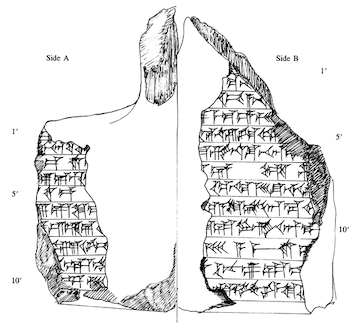Edurgina (temple of Bēl-ṣarbi at Bāṣ)

Hand-drawn facsimile of BM 050582, an inscribed prism fragment attributed to Esarhaddon recording the restoration of Edurgina. Image reproduced from P. Gerardi, "Prism Fragments from Sippar: New Esarhaddon Inscriptions," Iraq 55 (1993) p. 132 fig. 4.
Bāṣ's principal temple Edurgina, which was dedicated to the god Bēl-ṣarbi (Lugal-asal), is known to have be rebuilt twice in the first millennium BC: first by the Assyrian king Esarhaddon (r. 680–669 BC) and then by the Neo-Babylonian ruler Nebuchadnezzar II (r. 604–562 BC).
Names and Spellings
The Sumerian ceremonial name of Edurgina (or Etušgina) means "House, Established Abode."
- Written Forms: e₂-dur₂-gi-na (or e₂-tuš-gi-na).
Known Builders
- Neo-Assyrian (ca. 911–612 BC)
- Esarhaddon (r. 680–669 BC)
- Neo-Babylonian (ca. 625–539 BC)
- Nebuchadnezzar II (r. 604–562 BC)
Building History
A late Neo-Assyrian king, presumably Esarhaddon, claims to have built Edurgina anew; that deed is known from a text preserved on a small fragment of a clay prism and the identity of its royal author is not entirely certain, although it is generally assumed to have been Esarhhadon based on the material support, contents, and find spot.
Several inscriptions of the Neo-Babylonian king Nebuchadnezzar II state that he had had Edurgina built anew. Those texts, however, do not provide any information about that temple's rebuilding.
Archaeological Remains
Edurgina has not yet been positively identified in the archaeological record, principally since the modern location of Bāṣ is still unknown.
Further Reading
- George, A.R. 1993. House Most High. The Temples of Ancient Mesopotamia (Mesopotamian Civilizations 5), Winona Lake, p. 80 no. 226.
Naomi Weir & Jamie Novotny
Naomi Weir & Jamie Novotny, 'Edurgina (temple of Bēl-ṣarbi at Bāṣ)', Babylonian Temples and Monumental Architecture online (BTMAo), The BTMAo Project, a sub-project of MOCCI, [http://oracc.org/btmao/Bas/Edurgina/]